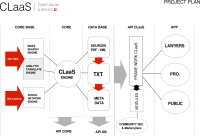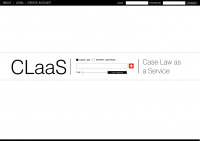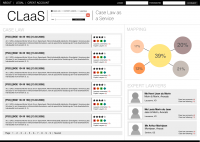This is an old revision of the document!
Case Law as a Service (CLaaS)
 Many decisions on the national and international levels are available, but not accessible. Information is stored in opaque formats, without adequate metadata and can only be accessed with poor search tools. The aim of the challenge was to create a framework for case law as a service (CLaaS), that is, an infrastructure that allows users and any kind of applications easy access to case law.
Many decisions on the national and international levels are available, but not accessible. Information is stored in opaque formats, without adequate metadata and can only be accessed with poor search tools. The aim of the challenge was to create a framework for case law as a service (CLaaS), that is, an infrastructure that allows users and any kind of applications easy access to case law.
CLaaS is at the same time an API for accessing cases, a software to manage cases and a universe with Appstore to manage a basic application with added views and features on top of it. CLaaS will integrate into social media to include comments, preferences, recommendations, personal bookmarking and reputation.
Mockup Design
For the Swiss Federal Supreme Court, Alexander has built a crawler, which can be accessed here: http://46.20.244.65:8090/
Cases should be part of the semantic web. Reto and Jörn have built a translation into linked data (RDF). Tools based on linked data can immediately be used to search and interact on that data: … link to that project …
Collecting a large number of cases will however make it even more difficult to find the right cases. Currently most systems will present cases and list of cases in pure text format. The advantages of graphics (one image says more than one thousand words) are not used.
What kind of visualizations can be useful:
1. Visualize one case: Cases are often long (10-30 pages or even more) and it is time consuming to identify rules and reasonings of the court. Cases can be annotaded with Icons and the reasoning can be displayed in a structured manner (Case matrix) (Christian and Franziska are preparing an example case preparation for that) This is listed as a seperate project Case Law Linked Data
2. Visualize a list of cases: Hitlists and other lists of cases can be annotated with easily accessible information by icons indicating case outcome, type of case, type of reasoning, area/region of the court etc.
3. Visualize the connection between cases: Cases often cite each other. This can be displayed in graphs that also convey further information (metadata).
4. Geographic visualization of a large number of cases: When a search retrieves a large number of cases (1000 or more) it is impossible to even glimpse over this list of cases. Facets help there but are not easily comprehensible because they just consist out of text and many numbers. A graphical visualization could help there. Oleg will present an interactive display of cases on a world or regional map together with a timeline. This display can also be animated to show how the searched topic evolved during time. We can imagine many other statistical presentations of the data. Oleg did a really nice prototype for that. It is listed as a seperate project …
Include links to your demo and/or source code.
Data
* 5000 cases of the Swiss federal court
* access to Swisslex and sample data and metadata from Swisslex
* access to UN Human Rights Cases
* access to ECHR Cases
Team
- Jean-Henry Morin, UNIGE Information Systems Security “Security is bypassed not attacked” (Idea+Des+Dev)
- Julius Chrobak, http://mingle.io “Query API for open data” (Dev)
- Christian Laux, Laux Lawyers “IT Law is our passion” (Idea)
- Alexander Poltorak, Free IT Foundation “Open Hardware & Free SW” (Idea)
- Florian Ducommun, HDC Lawfirm, CC “Please copy & share my work”
- Friedhelm Weinberg, HURIDOCS “Make available and accessible human rights case law around the world”
and others - please fill add yourself and add your contact details
Licenses
- CC BY-SA
- AGPL
Links
- Relevant documentation …
- Blog or forum posts …
- Tools you used …


